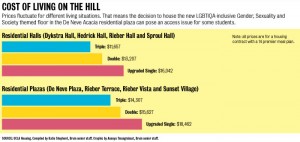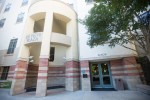Living away from home is one of the most challenging aspects of your typical freshman year. Now imagine you could take that challenge, but add daily support from people who share your interests and experiences. Sounds ideal.
That’s the goal of residential theme communities. Comprising six floors out of the dozens that stretch from Hedrick to Dykstra, theme communities are a form of housing organized by the Office of Residential Life, each with a specific topic or cultural focus.

The newest theme floor, launched this year, is the Gender, Sexuality, and Society community located in De Neve Acacia, which caters to lesbian, gay, bisexual and transgender, intersexual, queer or questioning and allied students, as well as students who are interested in learning more about LGBT issues.
While the focus of theme floors may be to educate and include residents, one major obstacle remains to including students of all backgrounds: It is priced too high for some students to afford.
The Gender, Sexuality, and Society community is located in the more expensive plaza-style housing, in contrast to the majority of the other theme communities, which are located in residence halls.
On a 14 regular meal plan, living in a double in a normal residence hall costs $12,767 per school year. The cost of living in a double in De Neve Plaza, where the themed floor is located, on the same meal plan is $15,187.
This cost disparity prevents students from low-income families who may be interested in living on the LGBT-themed floor from being able to afford it. The high price tag is enough to thwart the otherwise commendable principle of inclusiveness espoused by the new community.
Potential routes to increase accessibility could include reserving half a floor in a residence hall for the theme community, or asking students who cannot afford the difference between a hall and a plaza to demonstrate financial need and offering them aid to bridge the gap.
Eight other University of California schools offer some form of LGBT-themed housing. While this addition to UCLA’s residential offerings is hardly revolutionary within the UC system, it is a positive and necessary step toward developing more supportive housing.
But the cost is a problem that the Office of Residential Life should look to resolve in coming years.
The reason the Gender, Sexuality, and Society community is located in Acacia is because it’s only a pilot program, said Sharon Chia Claros, the resident director of De Neve Acacia-Birch.
Because it’s the program’s first year, the Office of Residential Life wasn’t sure how many students would choose to join, meaning the rest of the beds on the floor would need to be filled by random assignment.
Rather than reserving a floor in a residence hall, which has 90 to 100 beds, a plaza floor with approximately 33 beds was chosen as a safer bet, Claros said.
While that logic is certainly valid, potentially excluding interested students from being able to sign up is not. In addition, the larger theme floors have no guarantee of being filled, meaning random students may be assigned to fill those rooms as well.
It should be no different to randomly place people on a floor dedicated to Afrikan Diaspora Studies than to place them on one devoted to Gender, Sexuality, and Society – these issues affect UCLA students regardless of how they identify.
Additionally, by making the floor more expensive, it may have automatically been more difficult to fill the whole floor and prevented ORL from getting an accurate estimate of how many students might be interested in the community in the future.
The Gender, Sexuality, and Society community is an essential addition to UCLA’s residential life, and one that will hopefully grow into an on-campus mainstay over the next several years. As such, residential offerings based on interest and identity cannot unfairly be constricted by financial need.
